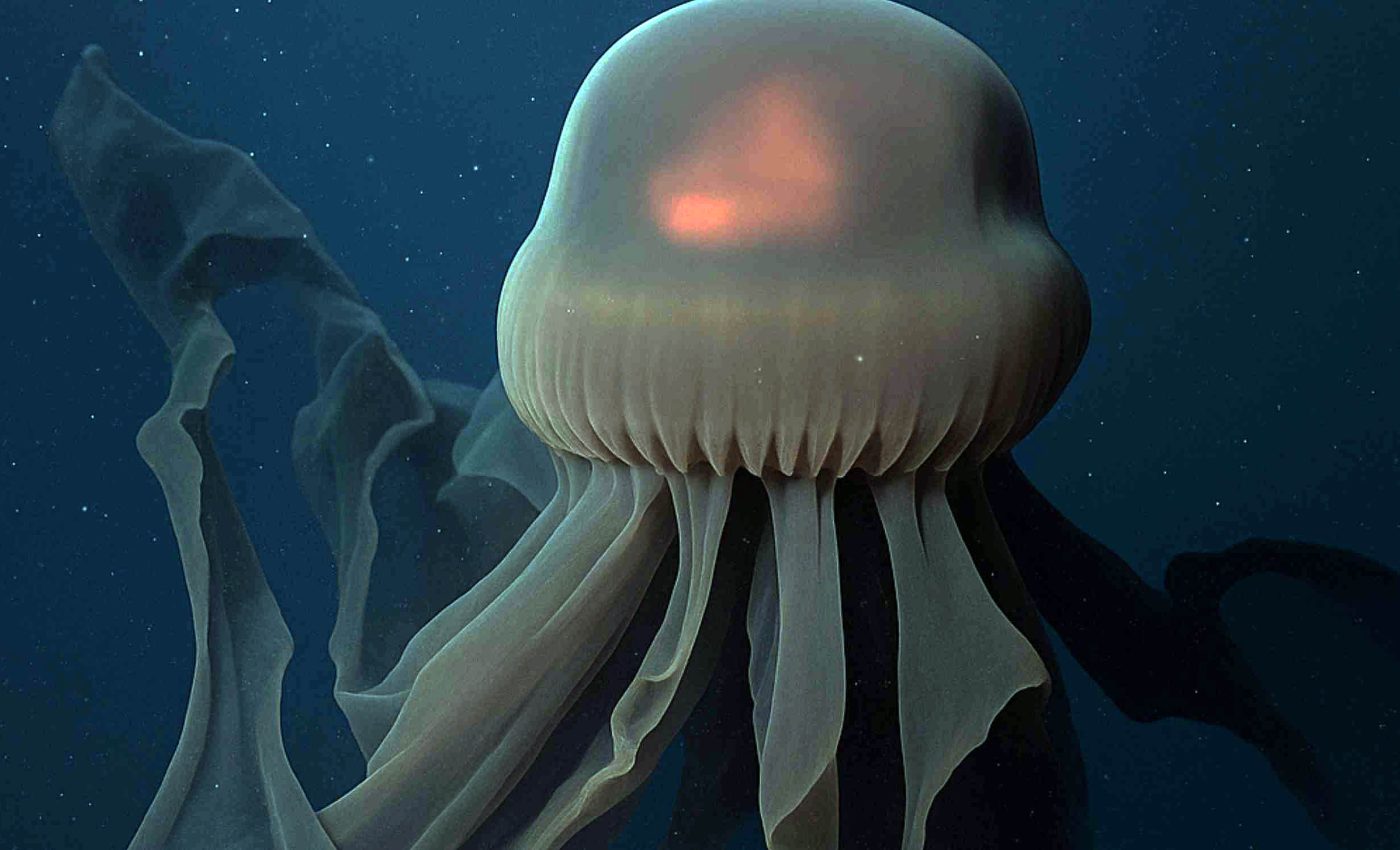
Giant phantom jellyfish spotted swimming under a newly broken-off iceberg
An enormous iceberg the size of Chicago recently split away from the George VI Ice Shelf. In the midst of that dramatic break, a research team in Antarctica witnessed a surprising encounter with an elusive creature.
Expedition co-chief scientist, Dr. Patricia Esquete of the Centre for Environmental and Marine Studies (CESAM) and the Department of Biology (DBio) at the University of Aveiro, Portugal, was part of the group that explored this newly opened section of ocean.
Researchers found an impressive web of corals, sponges, icefish, and enormous sea spiders thriving beneath the floating ice.
An iceberg breaks off
When iceberg A-84 separated from the Antarctic Peninsula in January 2025, it revealed an untouched seafloor. This hidden environment had been concealed under ice hundreds of feet thick for many decades.
Most scientists expected sparse life in those cold depths. Instead, the remotely operated vehicle (ROV) SuBastian captured footage of vibrant communities at depths reaching down to 4,300 feet (1,300 meters).
Window into an unknown ecosystem
Deep-sea ecosystems often rely on nutrients drifting down from above, yet this region remained sealed beneath thick ice for centuries.
Ocean currents may transport crucial resources, allowing surprising biodiversity to flourish in complete darkness.
Scientists discovered corals, icefish, and unusual invertebrates. They also stumbled upon the giant phantom jelly, a massive predator that has seldom been observed by human eyes.
Meet the giant phantom jelly
The giant phantom jellyfish (Stygiomedusa gigantea) can have a bell measuring more than three feet (1 meter) across, with four trailing arms that can reach over 33 feet (10 meters).
Researchers first collected a specimen of this ghostly jelly in 1899 but only recognized it as a distinct species around 60 years later.
Its mauve body appears translucent. Instead of normal tentacles, those ribbon-like arms help capture prey and draw it toward the jelly’s central mouth.
Phantom jelly intelligence
Researchers noted behavior in the giant phantom jelly that suggested a level of control and coordination not typically seen in jellyfish.
Its arm movements appeared deliberate, almost cautious, as it maneuvered through narrow gullies on the seafloor.
Though jellyfish lack a brain, some species use a nerve net to process environmental cues.
The team believes that future analysis of this footage could provide rare insight into how deep-sea invertebrates without centralized nervous systems respond to complex terrain .
Ancient ecosystem growth
One large sponge, that probably grew less than an inch a year, indicated that the ecosystem was old.
Scientists believe many creatures here have been thriving for decades or more, forming stable communities in a dark, pressurized environment.
“We didn’t expect to find such a beautiful, thriving ecosystem. Based on the size of the animals, the communities we observed have been there for decades, maybe even hundreds of years,” said Dr. Esquete.
Persistent water flow below the ice shelf may bring nutrients from open water. Some species showed adaptations that suggested minimal dependence on direct sunlight.
Small anemones, brittle stars, and hydroids were spotted clinging to rocks. The combination of seafloor features and ocean patterns likely fuels these bustling ecological pockets.
A changing world
Antarctica’s ice sheets have been losing mass for decades due to climate change. Many glaciers and shelves are thinning, and large icebergs are calving more often.
“The ice loss from the Antarctic Ice Sheet is a major contributor to sea level rise worldwide,” said expedition co-chief scientist, Sasha Montelli of University College London (UCL). Scientists on this mission aim to gather data that can improve projections for future changes.
Clues hidden in rock samples
In addition to studying marine life, the team collected geological samples from the newly exposed seabed.
Using push cores – narrow tubes pressed into sediment – they extracted layers of material that could reveal a timeline of past environmental changes.
These samples help reconstruct ice movements and sedimentation rates. As Eugenio Andrés Veloso of the Chilean Geological Survey sorted through the material, he noted that certain layers may even hold microfossils that offer a record of ancient ocean conditions long before the ice shelf existed.
Autonomous underwater helpers
In addition to ROV SuBastian, researchers deployed gliders to measure temperature, salinity, and biological activity.
Preliminary analyses show that meltwater from George VI influences the ocean’s nutrient balance in this region.
Gathered measurements will help the international team piece together how currents move materials beneath the ice.
They hope to understand why these habitats remain so productive despite the dark conditions and great depths.
Implications for science
Exploring a section of newly-exposed seafloor offers a rare glimpse into what normally lies hidden. Observations of corals, sponges, and large predators challenge assumptions about what can endure under thick ice.
Researchers suspect they have spotted several undescribed organisms. Documenting these species may reshape ideas about Antarctic biodiversity and how life survives in such harsh conditions.
Looking to the future
With each shift in Antarctica’s ice coverage, new areas open for investigation. Data gathered here could guide future expeditions and highlight the importance of safeguarding fragile habitats.
Scientists anticipate ongoing research as samples return to labs around the world.
By studying every layer – from ice shelf behavior to hidden ecosystems – experts aim to piece together Antarctica’s intricate environmental puzzle.
Credits: ROV SuBastian / Schmidt Oceanographic Institute.
—–
Like what you read? Subscribe to our newsletter for engaging articles, exclusive content, and the latest updates.
Check us out on EarthSnap, a free app brought to you by Eric Ralls and Earth.com.
—–













